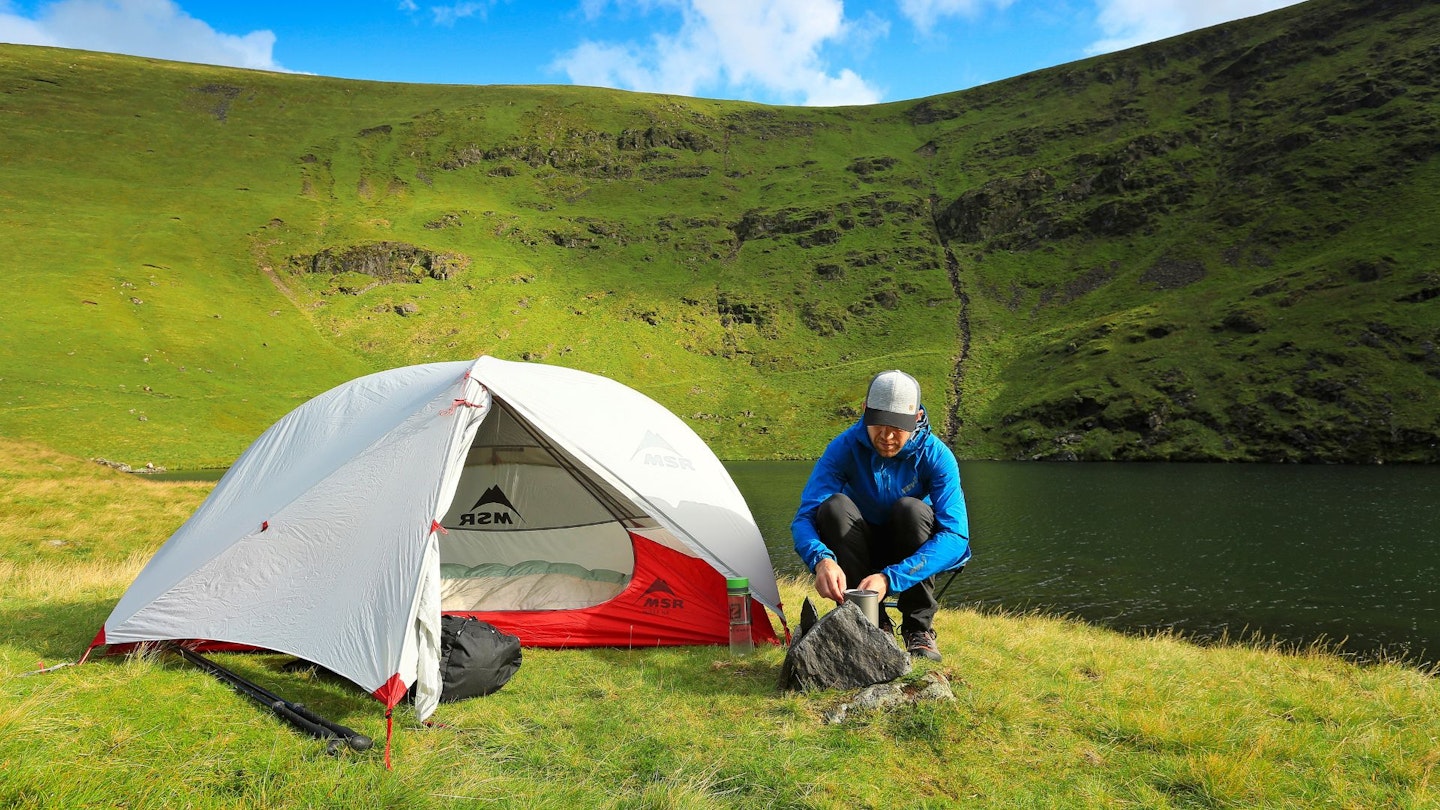Wild camping can give you those incredibly rewarding moments in nature that only ever come along now and then. Think burnt-orange skies at sunset, belly laughs with friends or that rare, quiet solitude that can feel so special.
But get it wrong and it can be a torturous, sleepless experience. If you’re not careful, you’ll be lying awake all night as your tent is thrown around by the wind like a rag doll.
Pack inadequate kit and you might find yourself shivering uncontrollably at 4am. Or worse – enduring what feels like a lumpy, slanting and wholly uncomfortable mattress for eight restless hours.
To make the most of your wild camping experience, you've got to get the basics right. Avoiding the schoolboy errors takes some research and planning – that’s where this guide comes in.
Our experienced team (learned from their own errors) has compiled our ultimate guide to wild camping, covering everything from toilet duties to water filtration and tent pitching. So let's get stuck right in, shall we?
What is wild camping, anyway?
Wild camping is essentially sleeping in the great outdoors, but not on an official campsite. It's pitching your tent or bivvy on a mountain summit, snuggling into your sleeping bag in a secret cave or sheltering under your tarp next to a tranquil tarn.
How to wild camp
If you're planning to wild camp, there's a certain code you need to respect. Doing so is not only important for the sake of other people, but also for the health and preservation of outdoor environments.
'Leave No Trace' is the key code to keep in mind. It means that after you’ve spent a night wild camping, no one should be able to tell that you were ever there. It also means respecting the environment and not hindering the enjoyment of other people in the great outdoors, or those who live and work in the countryside.
You can find a full list of rules in the image below, which includes things like pitching up late in the evening, leaving early in the morning and keeping your groups small.
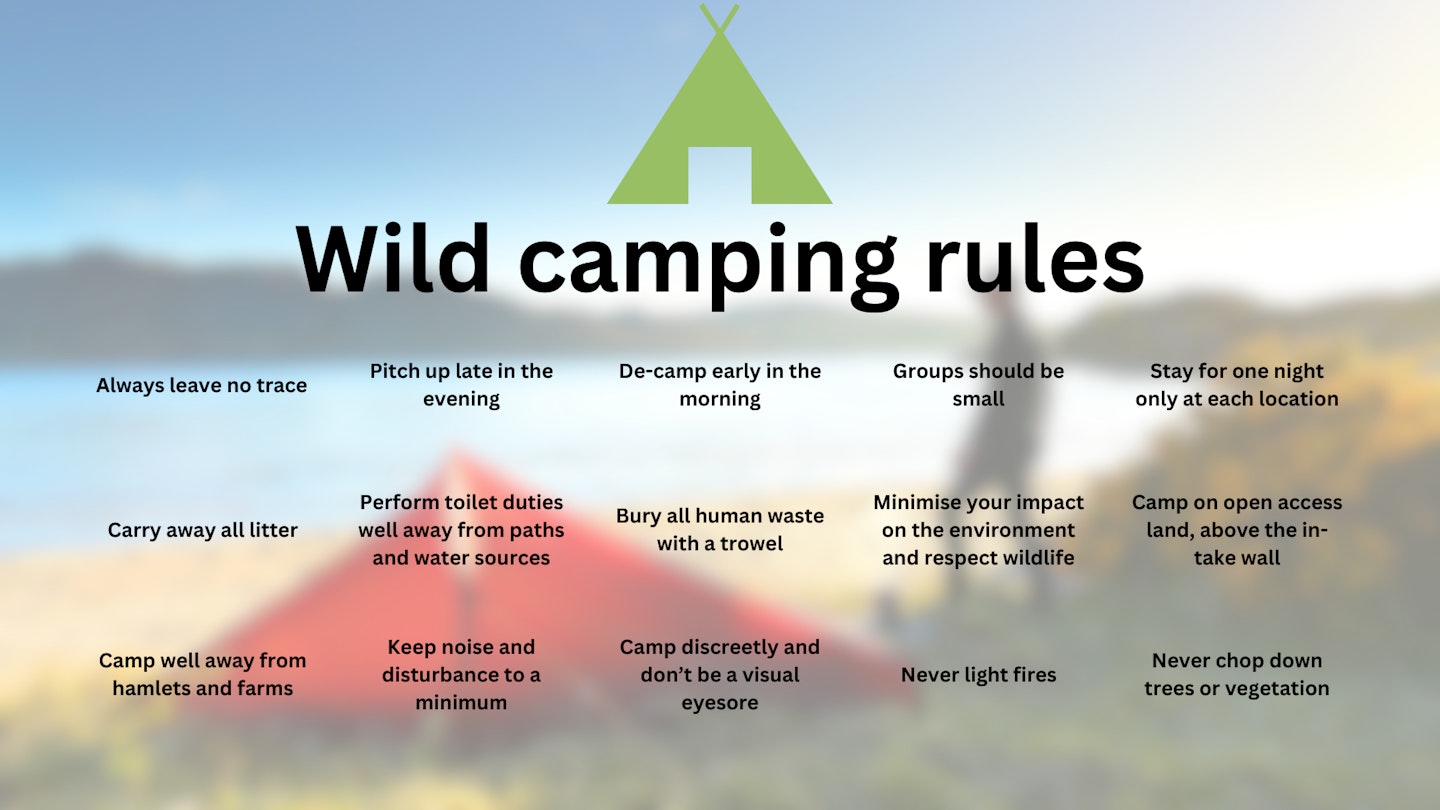
Is wild camping legal?
This is a complicated question, and you'll find a more detailed answer on our page that also spells out the key principles of the Wild Camping Code, which every responsible wild camper should know off by heart.
The shorter answer is that the law varies across the UK. In all of Scotland (except parts of Loch Lomond and The Trossachs) wild camping is legal so long as you follow the Outdoor Access Code (leave no trace and do not disturb people or animals).
Outside of Scotland, however, there is no legal right to camp wild in the UK. Technically, in the rest of England, Wales and Northern Ireland, you can only wild camp if you have the landowner’s permission.
However, in many mountain areas such as the Lake District, there is a long tradition of wild camping, and as a result sleeping in the fells has been unofficially tolerated for decades. Particularly if you adhere to the rules above and treat the landscape with the respect it deserves.
See our full answer on whether or not wild camping is legal for more.
Where should you wild camp?
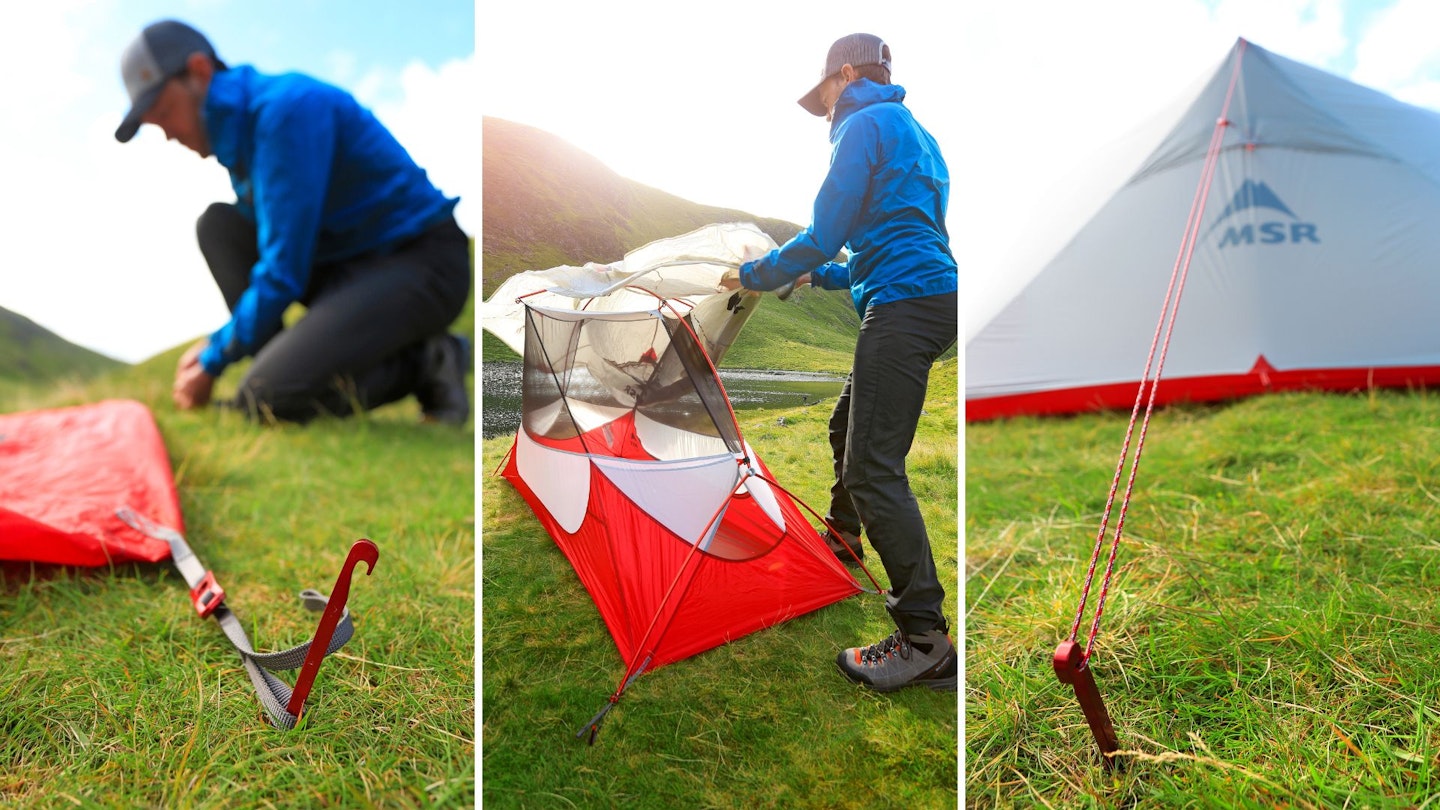
So, we've just covered the legalities of wild camping across the UK, but now let's talk about where to actually set up camp.
To start with, it's important you don't camp close to houses, farms, roads, railway lines, working quarries or fields that might contain crops or livestock. You definitely don’t want to camp on MoD land, or archaeological and historical sites, either.
Also avoid nature reserves, especially between 1 March and 31 July, in order to protect ground-nesting birds. Your goal is to enjoy nature, not destroy it.
When picking a spot, maps will give you the best sense of the local terrain and surrounding landscape.
As a starting point, look for open access land, depicted within an orange border on 1:25k OS maps. This includes mountains, moors, heath and downland, as well as common land. You have a legal right to walk across this land. As we've already mentioned, you don’t always have the right to camp here, but it is often tolerated in more remote areas.
Level, well-drained ground is preferable to anywhere too sloped, boggy or rocky. Look for flat areas where you’ll be able to pitch a tent. Use map contour lines to work out changes in elevation – the closer together the lines, the steeper the terrain.
Green dashed lines are used to indicate public footpaths and bridleways, while green diamonds show a long-distance trail. It’s better to camp slightly away from these paths.
Ideally, you also want to be close to a water source such as a lake, stream or spring (marked ‘Spr’ on maps).
How to find a good wild camping spot
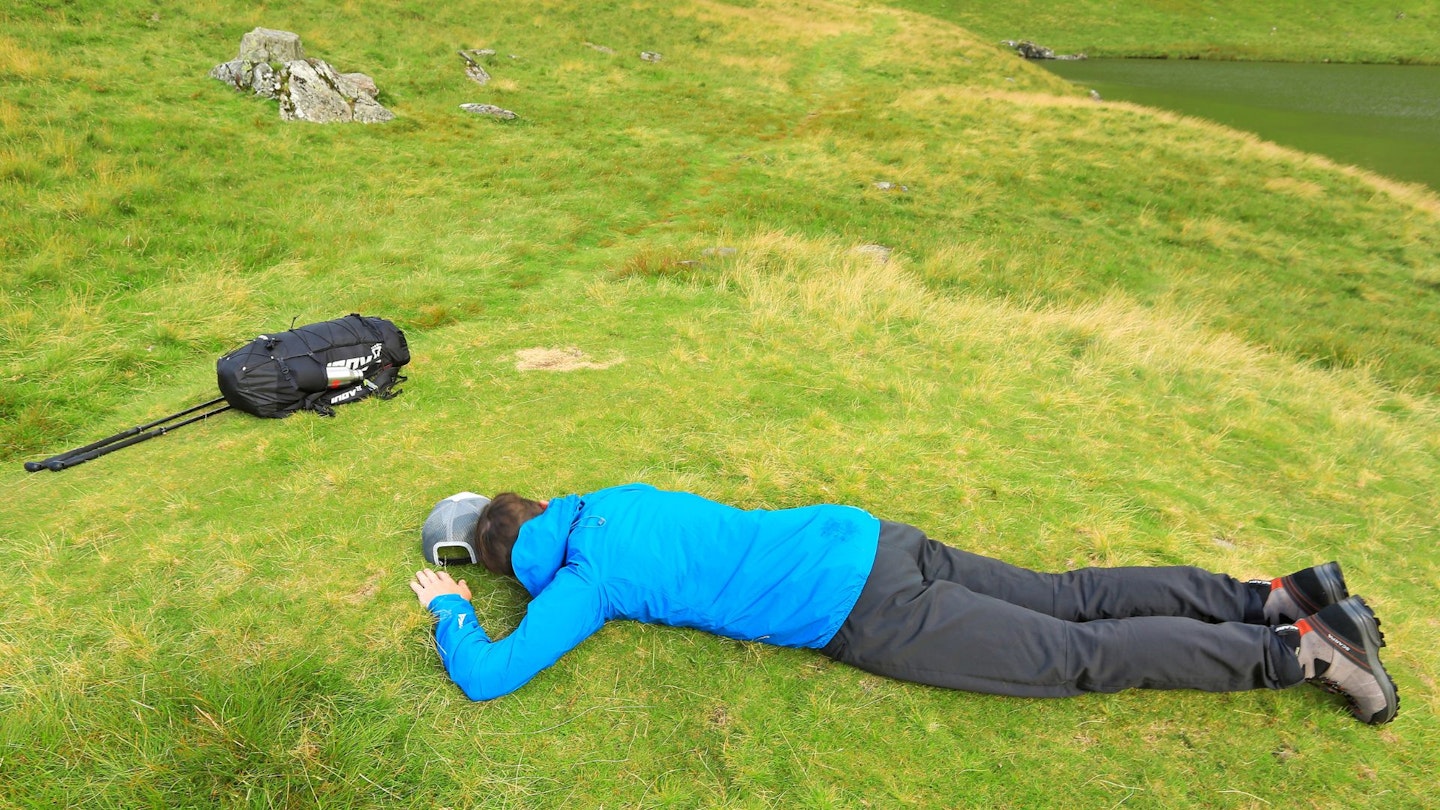
Find a patch of flat, soft and dry grass, devoid of any rocks or puddles of water. This will give you the best chance of a comfy night.
One trick is to lie down on the ground before you pitch your tent to check your chosen spot is sufficiently flat and dry, without any annoying grassy lumps or spiky rocks below your body.
If the weather is very gusty, some shelter from the wind – perhaps in the lee of a hill or shielded by a crag – is important too. Your tent should be parallel to the wind direction, with the lowest and narrowest part facing into the wind, ensuring gusts flow aerodynamically over your flysheet.
Fine-tune the flysheet’s tension to maximise clearance between the fly and inner; open the door and any vents to aid circulation and reduce the chance of condensation; and use guy ropes for added stability.
Is wild camping safe?
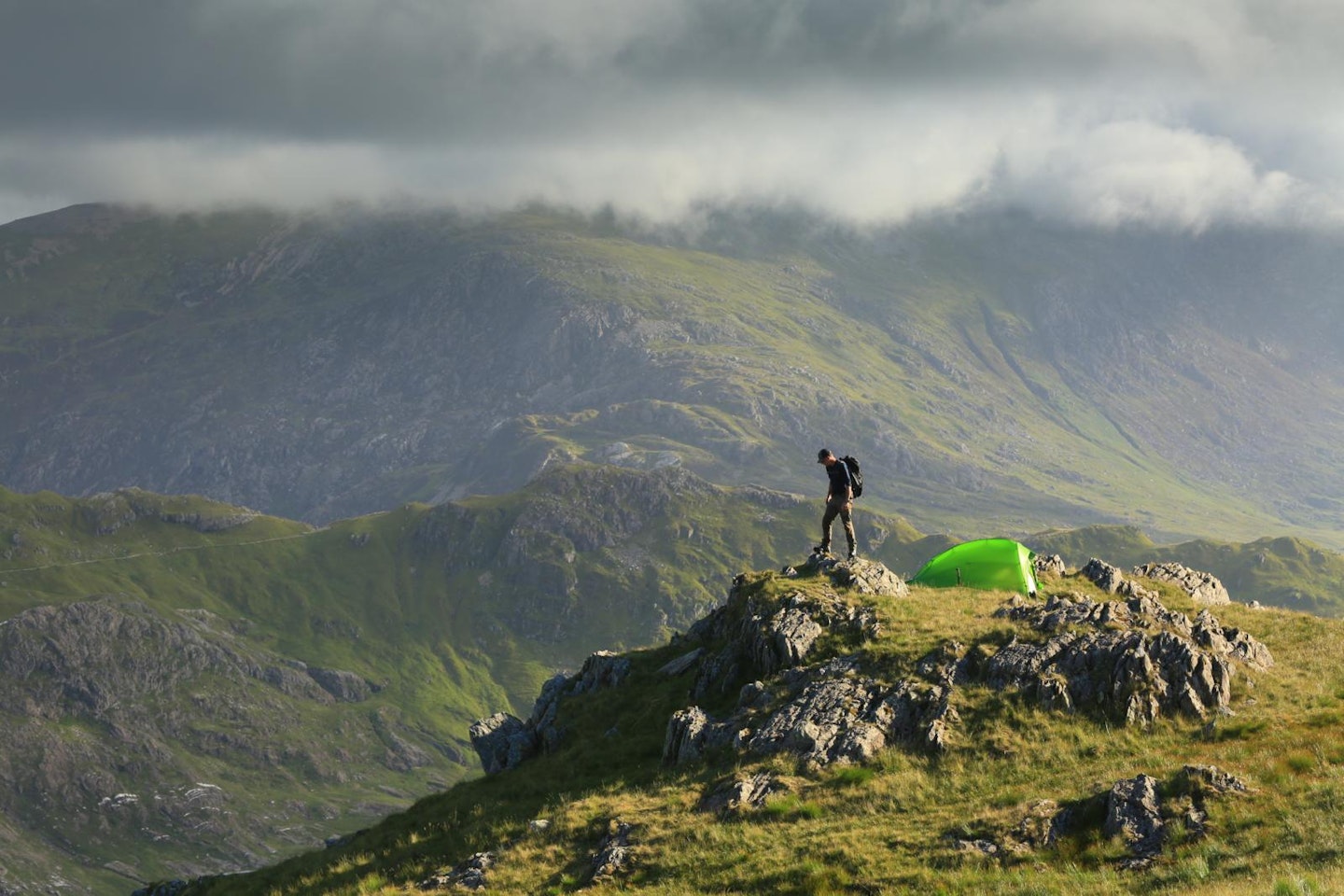
In short – yes. Wild camping is a fair bit safer than many other UK pastimes, especially if you follow all the guidelines. Don't pitch up on the edge of a cliff face and you're probably in for a very calm, uneventful evening.
We do acknowledge that being alone in a remote place after dark can be a bit scary, though. But, if you get worried by noises in the night, try not to feel deterred. It's quite a relief the first time you get spooked and shoot up to discover a stealthy cow passing by.
12 ways to plan your perfect wild camp
Now we've got all the serious stuff out of the way, let's get down to the fun stuff. Here are some top tips from our wild camping experts James Forrest and Ben Weeks on how to enjoy your dream night in the great outdoors.
1. Go gear shopping

A lot of this is self-explanatory. You’ll obviously need your tent, sleeping bag (with optional liner) and sleeping mat. For cooking you’ll need a camping stove, gas canister, lighter, pot, mug and spork, and for morale a flask of whisky or pack of Percy Pig sweets are irreplaceable.
Other essential items include head torch, trowel, several dry bags, rubbish bag, emergency rations and spare pegs and guy lines. Also a power bank for recharging devices if you like.
But don’t overdo it – an exceptionally heavy rucksack will give you backache and spoil the adventure. Be efficient with your packing and only take what you really need. If you're really feeling brave, check out our guide to bivvy camping and skip the tent entirely.
2. Check the weather
Look for a window of calm and settled weather. Also check the phases of the moon. A new moon and clear skies can mean superb stargazing. If you’re heading for the hills, also read the Mountain Weather Information Service (MWIS) forecast. This will give you a good idea of what to expect in terms of rain, wind, visibility and temperatures.
3. Carry safety kit
Always carry basic safety equipment with you – map, compass, GPS device, mobile phone, head torch and first aid kit. And let someone know your approximate route, where you’ll camp and what time you’ll be home. That way, in the unlikely event of an emergency, they can raise the alarm and provide useful info to Mountain Rescue.
4. Create a cosy bedroom
Nothing too complicated here. Simply inflate your sleeping mat and lay it in the centre of your tent. Place your sleeping bag over it and slide your sleeping bag liner (if you have one) inside your bag.
A dry bag stuffed full of spare clothes can act as a makeshift pillow, if you haven’t packed a camping pillow.
Remember also to ensure your sleeping bag’s temperature ratings are season appropriate. A good strategy is to aim for something slightly warmer than you’re likely to need – that way you’re prepared for an unexpected cold snap.
5. Keep things neat and organised
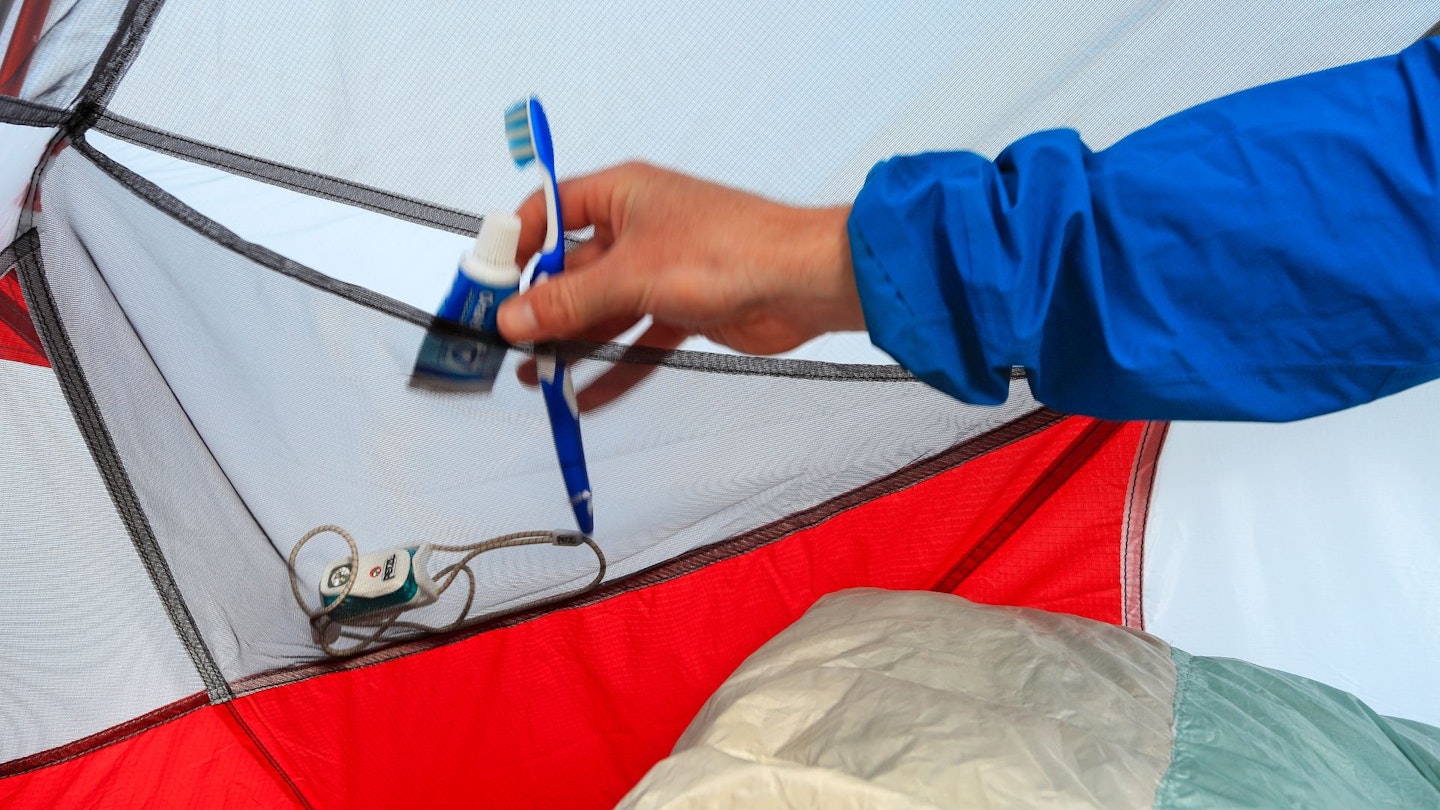
Organise your tent pockets so the things you need are close to hand: your headtorch for midnight loo breaks, toothbrush and phone. If you’re bivvying, put them in a dry bag near your head.
Get into the habit of clearing up as you go along, by putting the stuffsacks for your sleeping bag, mat and any other camp kit into the tent bag. Yes, it makes for a tidy camp, but more usefully it’s all safely stored together and easy to pack away when you leave.
6. Keep the trowel handy
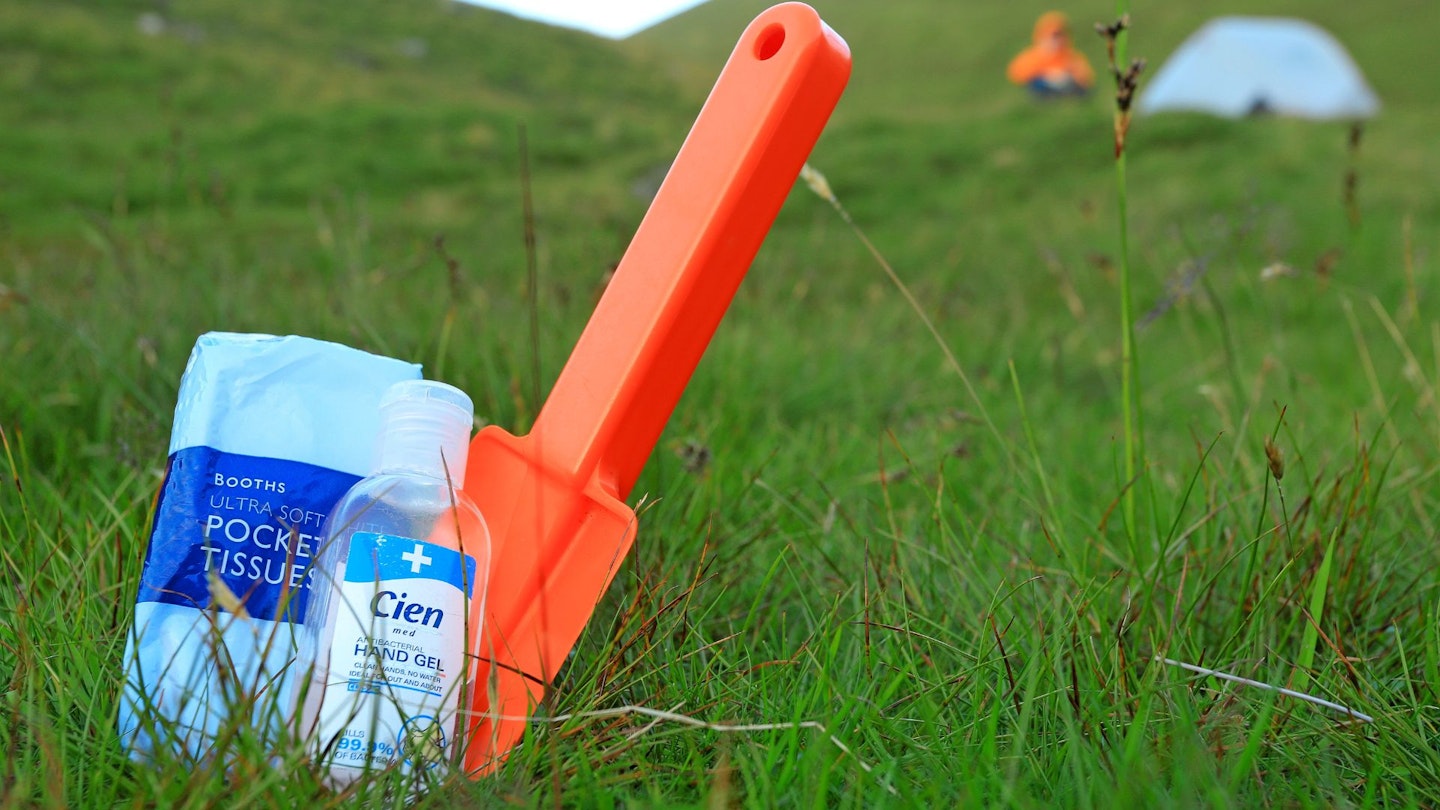
Stake the trowel outside your tent, or if you’re camping in a group put it somewhere in the middle so it’s easily accessible.
7. Plan your meals
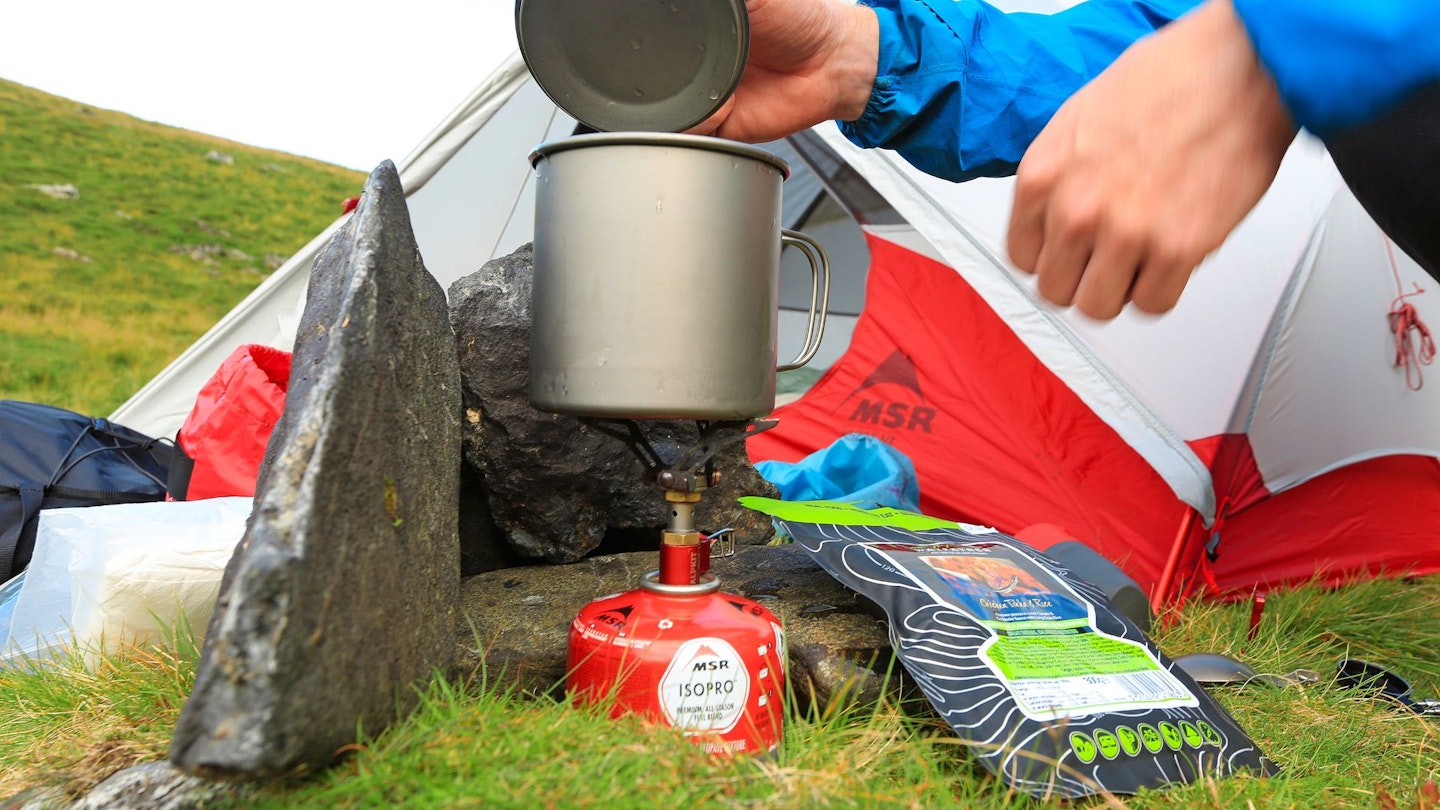
You can make things as simple or complicated as you like, be it the humble Pot Noodle or a five-star gourmet steak. A simple and tasty option, however, is an expedition meal from a brand such as Summit To Eat or Firepot.
These dehydrated or freeze-dried meals come pre-prepared in a pouch and all you have to do is add boiling water. There’s no washing up either, as you eat them out of the pouch. For breakfast, porridge pots and a coffee sachet are popular choices.
8. Search out safe drinking water
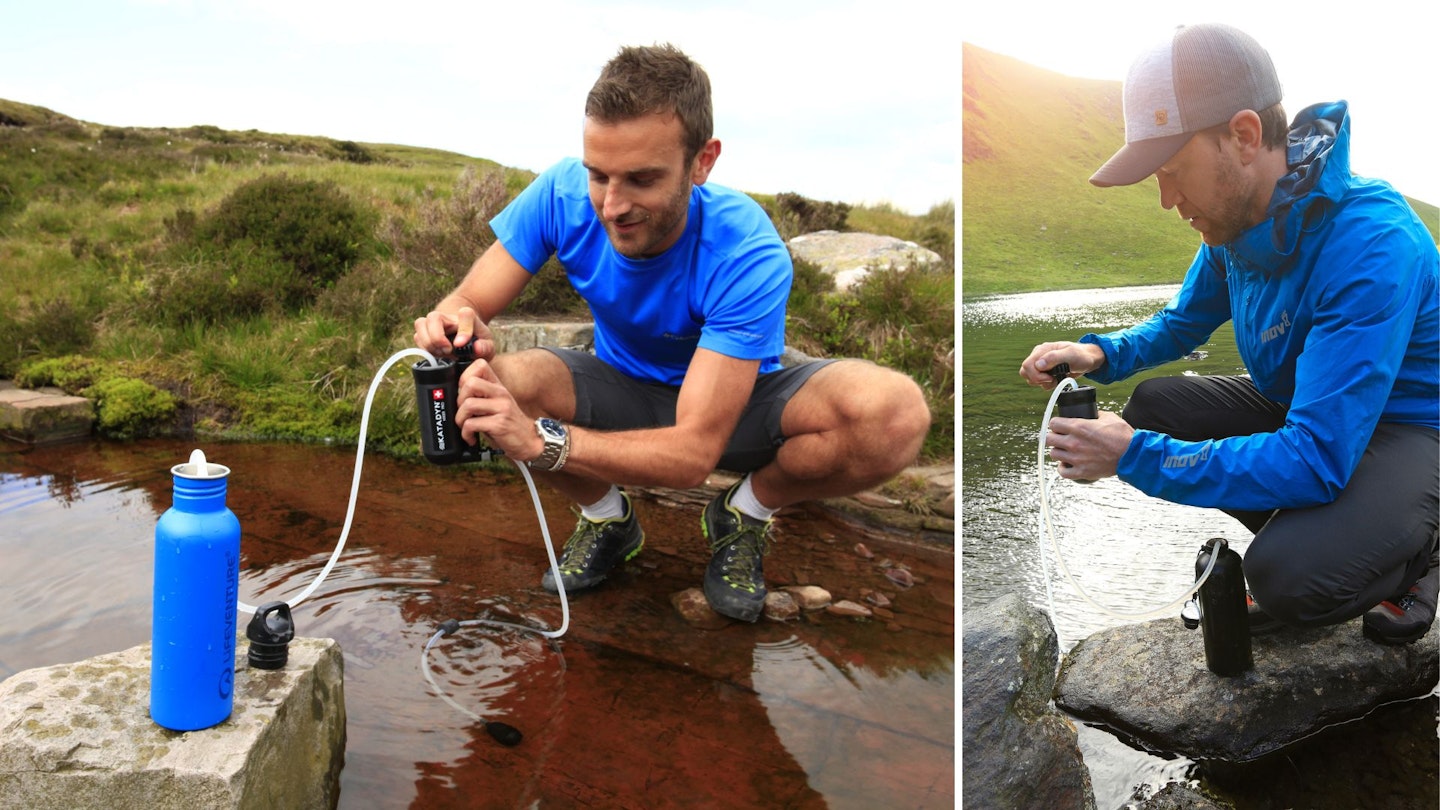
Water is heavy, so you’ll probably need to re-supply at a water source such as a stream or tarn. Running water is generally safer than still water and it’s best practice to collect from as close to the source as possible. Remember to check upstream for dead sheep or waste, too.
Your best bet for drinking water is bottles with integrated filters such as the LifeStraw Go. Simply fill up and drink – it’s that simple. But for cooking water, you’ll need to boil it, add water purification tablets or use a more advanced water filtration system. If you’re only going for a one-night wild camp, however, you might be able to carry enough water, thus avoiding the need for filtering.
9. Keep on top of the washing up
Yes, it’s the last thing you want to do before bed, but it’s better than trudging to the stream before your first cup of tea to scrub off last night’s crusty noodles. Heather makes a great scouring brush.
10. Don't go to bed cold!

If you go to bed cold, it’s unlikely that you’ll warm up. Instead, think about retaining body heat. Keep your insulated jacket on and go for a brisk stroll to raise your body temperature before hunkering down.
11. Give your tent a morning shake
First thing in the morning, if it’s been raining or your tent is covered with dew, give it a good shake to get the worst of the moisture off. With any luck, the sun will burn off the rest while you have your morning brew and ponder the spectacular view.
12. Do a final sweep before heading home
Little things like tent pegs and gloves are easy to leave behind. When you’re packed up, do a final sweep of your campsite to make sure you haven’t left any kit or litter behind.
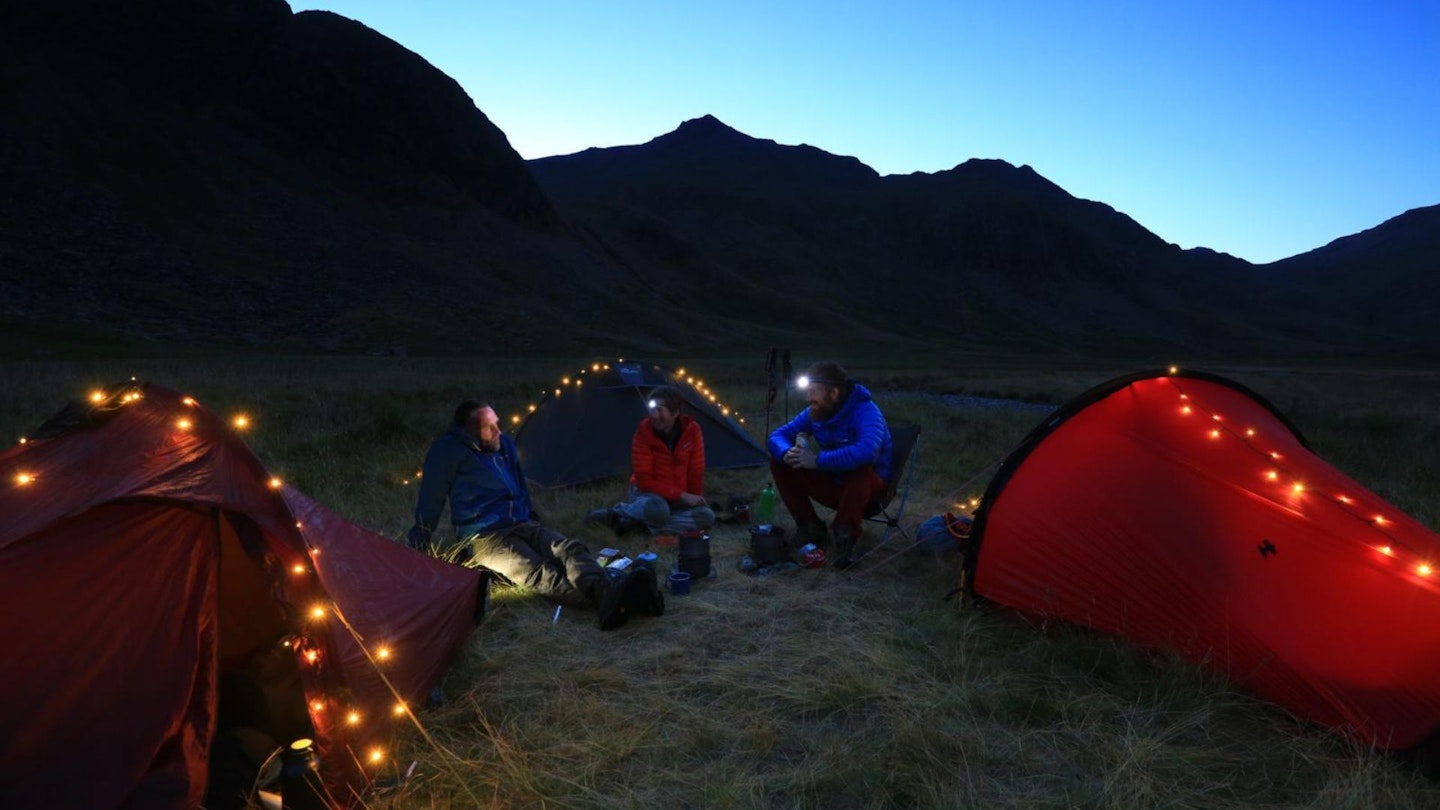
Who's writing?
This wild camping guide has been written by Ben Weeks and James Forrest.
Ben is the gear editor for Trail magazine, Country Walking and Live for the Outdoors, and has been working on these titles for over 10 years. He's also a fully qualified mountain leader and climbing instructor.
James is one of the most respected and knowledgeable outdoor writers in the UK. Between 2017 and 2019 he set the fastest known time for climbing all 1,001 mountains in the UK and Ireland. In the process he wild camped over 100 times.
